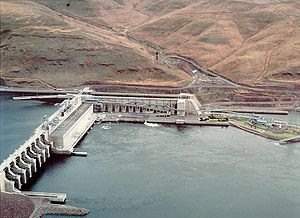forum
library
tutorial
contact

Few Would Lose from
Removing Snake River Dams
by Daniel Malarkey
Sightline Institute, September 19, 2019
|
the film forum library tutorial contact |

|
Few Would Lose from
by Daniel Malarkey
|
And making whole the irrigators and grain barging companies would cost little.
 “Breaching Snake River dams could save salmon and orcas, but destroy livelihoods” reads a March 24, 2019 cover story of the Sunday Seattle Times Pacific NW magazine. Such headlines reinforce the misperception that removing the dams would deal a blow to the economy of Eastern Washington. The recent economic impact analysis by ECONorthwest (ECONW) shows just the opposite: a river recovery project would add hundreds of jobs to the lower Snake River basin.
“Breaching Snake River dams could save salmon and orcas, but destroy livelihoods” reads a March 24, 2019 cover story of the Sunday Seattle Times Pacific NW magazine. Such headlines reinforce the misperception that removing the dams would deal a blow to the economy of Eastern Washington. The recent economic impact analysis by ECONorthwest (ECONW) shows just the opposite: a river recovery project would add hundreds of jobs to the lower Snake River basin.
In 2002, the Corps estimated the costs of breaching the dams and restoring the river would total $860 million in 1999 dollars or $1.6 billion in 2018 dollars. This influx of spending for engineering, construction, and environmental mitigation during and long after removal would increase employment, income, and output through the region. According to the modeling by ECONW, a capital project of this size would add over 300 jobs per year in the counties adjacent to the river for more than 30 years.
Restoring the lower Snake River would also bring more recreational visitors to enjoy white water recreation and other riverside activities. ECONW projects that by 2040 annual visitors would increase by 1 million compared with a baseline of 1.4 million visitors if the dams remain. Assuming visitor spending amounts in Asotin County from a 2016 study, those new visitors would spend an additional $80 million per year.
More jobs overall but some job loss
These increases in spending and net employment would boost the economy in southeastern Washington, but not every person in the region would benefit from breaching. The photo essay that accompanied the Seattle Times article offered a portrait of the work lives of the barge operators who could lose their jobs if barge traffic stops in Pasco, Washington, instead of continuing up the Snake River to Lewiston, Idaho.
But policymakers should keep any potential losses in perspective. According to state reports, inland water freight employed 248 people in all of Washington in 2017. None of these employers were located in the seven counties that comprise the southeastern corner of Washington where the lower Snake River is: Asotin, Benton, Columbia, Garfield, Franklin, Walla Walla, and Whitman. Tidewater, the leading barge operator, is headquartered far downriver in Vancouver, Washington.
Employers that do locate in the seven southeastern counties together employed over 175,000 people in 2017. National statistics show that monthly layoffs and discharges now average 1.2 percent per month. If southeast Washington follows that national average, then 25,000 people in those seven counties lose their jobs each year. Most are rehired after a job search of a few months. Every job is important to the person who holds it, but the larger context is important, too: the region has a dynamic economy where employers constantly add and subtract jobs from the labor market.
More specifically, the Kennewick-Pasco-Richland area has recently added about 3,000 net new jobs per year, an annual employment growth rate of 2.1 percent since 2000. That rate is well above the state average of 1.2 percent. Any individual job losses from breaching the dams could be absorbed in an already dynamic local economy that would surge from a boost of new spending.
Far from destroying livelihoods, as the Seattle Times fears, breaching the dams and restoring the river would boost the economy that centers on the lower Snake. Agricultural production would continue much as it is now with a boost to transportation employment as some grain shipments move from barges to trucks and trains. Hundreds of people would work on removing the dams and, once the river is restored, hundreds of thousands of new fishers and rafters and their spending would visit the river basin. The economic prospects of the region are brighter without the dams.
Economics says it is time to restore the Snake River
In this case, as in the three previous cases in this series, the recent ECONW report makes clear that breaching the dams on the lower Snake River is a win for the Northwest:
learn more on topics covered in the film
see the video
read the script
learn the songs
discussion forum
